This is a preprint.
Non-lytic spread of poliovirus requires the nonstructural protein 3CD
- PMID: 39464037
- PMCID: PMC11507938
- DOI: 10.1101/2024.10.18.619132
Non-lytic spread of poliovirus requires the nonstructural protein 3CD
Update in
-
Non-lytic spread of poliovirus requires the nonstructural protein 3CD.mBio. 2025 Jan 8;16(1):e0327624. doi: 10.1128/mbio.03276-24. Epub 2024 Dec 12. mBio. 2025. PMID: 39665531 Free PMC article.
Abstract
Non-enveloped viruses like poliovirus (PV) have evolved the capacity to spread by non-lytic mechanisms. For PV, this mechanism exploits the host secretory autophagy pathway. Virions are selectively incorporated into autophagosomes, double-membrane vesicles that travel to the plasma membrane, fuse, and release single-membrane vesicles containing virions. Loading of cellular cargo into autophagosomes relies on direct or indirect interactions with microtubule-associated protein 1B-light chain 3 (LC3) that are mediated by motifs referred to as LC3-interaction regions (LIRs). We have identified a PV mutant with a severe defect in non-lytic spread. An F-to-Y substitution in a putative LIR of the nonstructural protein 3CD prevented virion incorporation into LC3-positive autophagosomes and virion trafficking to the plasma membrane for release. Using high-angle annular dark-field scanning transmission electron microscopy to monitor PV-induced autophagosome biogenesis, for the first time, we show that virus-induced autophagic signals yield normal autophagosomes, even in the absence of virions. The F-to-Y derivative of PV 3CD was unable to support normal autophagosome biogenesis. Together, these studies make a compelling case for a direct role of a viral nonstructural protein in the formation and loading of the vesicular carriers used for non-lytic spread that may depend on the proper structure, accessibility, and/or dynamics of its LIR. The studies of PV 3CD protein reported here will hopefully provoke a more deliberate look at the presence and function of LIR motifs in viral proteins of viruses known to use autophagy as the basis for non-lytic spread.
Figures

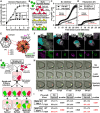
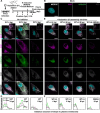

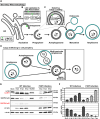

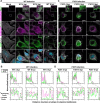
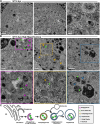
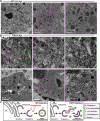


Similar articles
-
Non-lytic spread of poliovirus requires the nonstructural protein 3CD.mBio. 2025 Jan 8;16(1):e0327624. doi: 10.1128/mbio.03276-24. Epub 2024 Dec 12. mBio. 2025. PMID: 39665531 Free PMC article.
-
Exocytosis of Varicella-Zoster Virus Virions Involves a Convergence of Endosomal and Autophagy Pathways.J Virol. 2016 Sep 12;90(19):8673-85. doi: 10.1128/JVI.00915-16. Print 2016 Oct 1. J Virol. 2016. PMID: 27440906 Free PMC article.
-
Poliovirus induces autophagic signaling independent of the ULK1 complex.Autophagy. 2018;14(7):1201-1213. doi: 10.1080/15548627.2018.1458805. Epub 2018 Jul 20. Autophagy. 2018. PMID: 29929428 Free PMC article.
-
Selective Autophagy: ATG8 Family Proteins, LIR Motifs and Cargo Receptors.J Mol Biol. 2020 Jan 3;432(1):80-103. doi: 10.1016/j.jmb.2019.07.016. Epub 2019 Jul 13. J Mol Biol. 2020. PMID: 31310766 Review.
-
Varicella-Zoster Virus Infectious Cycle: ER Stress, Autophagic Flux, and Amphisome-Mediated Trafficking.Pathogens. 2016 Dec 10;5(4):67. doi: 10.3390/pathogens5040067. Pathogens. 2016. PMID: 27973418 Free PMC article. Review.
References
-
- Andino R, Kirkegaard K, Macadam A, Racaniello VR, Rosenfeld AB. 2023. The Picornaviridae Family: Knowledge Gaps, Animal Models, Countermeasures, and Prototype Pathogens. J Infect Dis 228:S427–S445. - PubMed
-
- Chumakov K, Ehrenfeld E, Agol VI, Wimmer E. 2021. Polio eradication at the crossroads. Lancet Glob Heal 9:e1172–e1175. - PubMed
Publication types
Grants and funding
LinkOut - more resources
Full Text Sources
